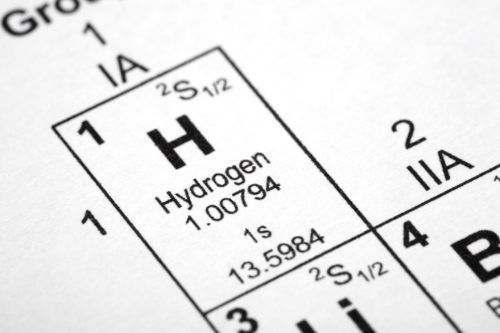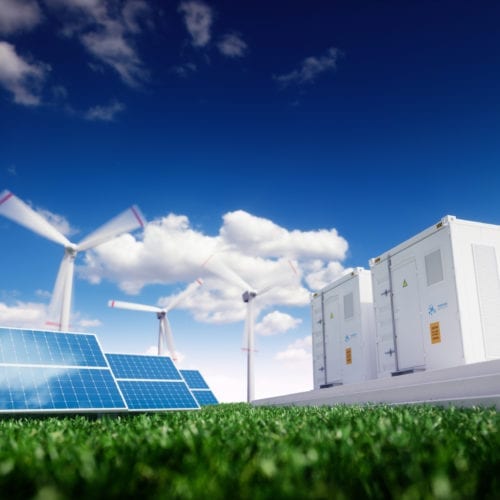Periodic table detail of hydrogen. Taken from public domain periodic table from nist.gov

Why NextEra’s Green Hydrogen Pilot Is a Big Deal
In its recent quarterly results call, US power giant NextEra announced that its utility subsidiary Florida Power & Light (FPL) plans to build a 20 megawatt electrolyzer to produce hydrogen from water. If approved by regulators, the plant will run on power from otherwise curtailed solar and feed hydrogen to burn in FPL’s Okeechobee gas plant.
On the global stage, the scale of this investment does not raise eyebrows. “Green” hydrogen electrolysis plants of a similar scale are underway in a number of other nations, and some are scheduled for completion by the end of this year. In the United States, the Los Angeles Department of Water and Power’s (LADWP) plan to convert its coal-fired Intermountain Power Plant in Utah to a mix of hydrogen and gas will involve a much larger supply of hydrogen from electrolysis.
However, what is important is not just the megawatts. It is why these two utilities are investing in this technology. LADWP has stated that its Intermountain hydrogen project is necessary to meet the utility’s 100 percent renewable energy target. NextEra has no such mandate forcing its hand; instead this is a voluntary move by a company that is also the nation’s largest wind and solar developer.
And this points to what is exciting about NextEra’s announcement: the potential to scale. FPL has plans to deploy 30 million solar panels by 2030, which at today’s wattage for utility-scale solar is around 12 gigawatts (GW). The utility also has an enormous fleet of gas plants.
Additionally, parent company NextEra own substantial solar, wind, and gas infrastructure across the nation. If this project is successful, there are a lot of places where NextEra could potentially site hydrogen electrolyzers.
Why Hydrogen?
The specific application planned by FPL solves multiple problems. First, it addresses the problem of what to do with “curtailed” solar and wind, which is the electricity generated from these sources that cannot be used and must be wasted.
This happens when the peak of solar output is mismatched with demand, and particularly when there is not enough flexibility in the system and/or the penetration of solar and wind is high. Relatively high levels of curtailment are already an issue in California.
Using otherwise curtailed solar or wind means that the electricity to make hydrogen can be essentially free. In wholesale markets, prices can even go negative, meaning it pays to take electricity off the grid.
And as we move towards a zero-carbon grid, there is also the problem of what to do when there is not enough solar and wind. While batteries can address this on shorter timeframes, high renewable penetration scenarios show a need for a flexible, on-demand source of generation that can last days or weeks. This particularly true during periods in the winter when both wind and solar output are low.
Gas generation often fills this gap at present, but it could also be addressed with either a mix of hydrogen and gas—as both LADWP and FPL are planning—or pure hydrogen.
Of course, hydrogen itself has much broader applications than just power. While many focus on the automobile market, hydrogen is showing promise for trucking, and is one of the few technologies with the potential to decarbonize industrial processes such as steelmaking and provide process heat. There are even applications in shipping and aviation.
H2 Ramp-Up
FPL’s announcement is also interesting in light of the rising interest in hydrogen electrolysis globally. In its recent Hydrogen Strategy, the EU is targeting 80 GW of electrolysis by 2030 (40 GW in Europe and 40 GW in neighboring nations). Germany has also released a hydrogen roadmap targeting 5 GW of hydrogen by 2030.
But while much of the action has been in Europe, truck maker Nikola is planning 700 hydrogen fueling stations across the United States—each of which would be supplied by ~20 MW electrolyzers—and has attracted some big partners. To get started, Nikola has already ordered $30 million worth of electrolyzers.
Additionally, Microsoft—one of the world’s largest renewable energy buyers—is also starting to explore hydrogen. The tech giant recently joined the Hydrogen Council and has been testing fuel cells as backup power at its data centers.
All of that said, there are still challenges to development of a green hydrogen ecosystem. Electrolyzers are still quite expensive, particularly when compared to the steam methane reforming (SMR) method of hydrogen production using natural gas.
However, manufacture is moving from manual to automated production as the sector matures, and many industry observers are predicting that this technology will follow the cost declines seen with solar and battery storage as it scales.
Another challenge is that in order to use a high portion of hydrogen in conventional power plants, there is a need to redesign some aspects of the plant, including the turbines themselves. Hydrogen can also both embrittle and leak from steel containers, which has led to the use of carbon fiber tanks in many cases for storage and transportation. And in order to transport hydrogen in existing gas pipelines, many of these will need to be coated.
But a central problem may be simply be the uneven process of scaling. “It’s a chicken and egg problem,” explains Patrick Molloy, a senior associate in RMI’s Industry Program. “We are waiting on demand and the emerging capacity to supply.”
Going Big?
Regardless, Molloy says that NextEra’s announcement is significant. “This is one of the first developments of a large and innovative actor in the energy space, taking on an early and large project,” notes Molloy. “This is not a common occurrence in the United States right now.”
In the past, NextEra was a first mover with solar, wind, and battery storage. It is the long-term owner of some of the first concentrating solar power (CSP) plants ever built, and in 2009 FPL put online a 20 MW solar plant—one of the largest in the world at the time. Today the company’s investments in solar are measured in the gigawatts, not megawatts.
It is too early to know if NextEra will follow a similar path with hydrogen, but if it does it could be the beginning of the emergence of a market for green hydrogen in the United States.


